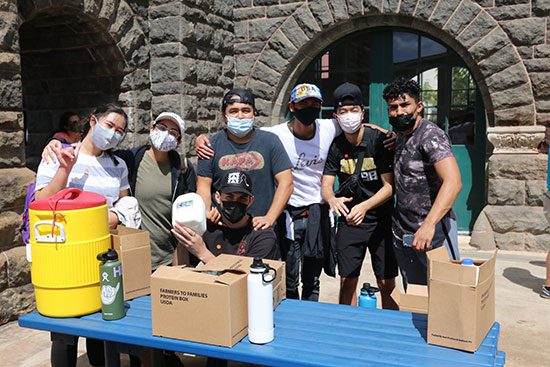
As Hawai’i continues to struggle with homelessness, local grassroots group Valoha Giving Movement (VGM) aims to rehabilitate O‘ahu’s houseless.
In December 2015, VGM began as the vision of O’ahu local Christina Bush. After abruptly losing her job as a college counselor, Bush saw the setback in her life as an opportunity to give back.
“I just knew I was good at resumes and dealing with people, so I started helping our homeless to help fight my own depression after getting laid off,” Bush says. “They (the homeless) helped me find my passion. I had to pick myself up, just like they did. I found my dignity and self worth and realized we need to help them do that as well.”
In addition to supplying material necessities, VGM assists the homeless with resume creation and interview skills. VGM’s main goal is to instill hope, dignity and purpose to the houseless citizens. Bush believes that by educating and creating lasting relationships with those in the homeless community, those she serves will go on to pay it forward to others in need.
As Bush puts it, “If you only give them (the homeless) food and clothes, in 10 years, you’ll still be giving them food and clothes.”
Many of the vagrants VGM works with end up becoming volunteers for the group, which offers them a chance to show off their existing skill sets and in the process gain new strengths they can use in the future.
“The V in Valoha stands for Value,” Bush says. “What we’re trying to do is remind people just how valuable they are. I believe some in this society view the homeless as having no viable skills, but many that I’ve met have college degrees.”
During Bush’s work in the non-profit sector, she began to question how federal money is used to solve the homeless problem on O‘ahu. In a Facebook post, she asked her followers: “How would you feel if your tax dollars were being used for grants to organizations (especially non-profits) to assist our homeless, but the organizations were only going out once or twice a year? How would you feel if local government put out to the public that a homeless encampment was being given referrals and services two to three months in advance of upcoming ‘sweeps,’ but you knew this wasn’t the case?”
Government provides most of the funding for homeless services. Federal funds are distrubuted to the state, which then contracts charities to create and run programs to assist those in need. This bureaucratic process ends up creating a gridlock in funds, and lack of oversight for how the non-profits are running.
The state also delegates local law enforcement to conduct ‘sweeps’ of areas with a high volume of homeless citizens. During the sweeps, property of the homeless is taken and kept at the police station or thrown away on the spot. Only after the homeless pay a substantial fee, which most are unable to do, are their belongings returned to them.
Ashley Aquino, a VGM volunteer, paints a disturbing picture of what goes on during the sweeps.
“They are trashing a working man’s work-clothes when he’s sixteen hours into his third shift for the week,” Aquino says. “They are trashing the piece of tarp someone had to dish out $40 to keep their important documents from getting wet during the storm. They are throwing away a babyʻs clothes her mother had to beg people to donate so her baby could stay warm at night.”
Bush, who is normally with the homeless during the sweeps, says that the trashing or confiscating of personal belongings causes real psychological harm as well as distrust towards local government and police.
“I know many of our homeless personally and the sweeps are not motivating anyone to look for employment, housing or even to handle their drug problems, if that is the case,” Bush says.
Aquino offers her perspective on how federal money could be better used to help the homeless.
“We (as taxpayers) are paying the city and other agencies to blow these houseless out of the complaint areas into other areas. Nothing is being accomplished,” Aquino says.
“All the money we pay the city, its officials, the people executing the sweeps, could be used to create shelters, temporary homes and start a fund through the federal government for forever homes to stop the cycle.”
Both Aquino and Bush agree there needs to be better monitoring by the state of organizations given grants to directly assist the homeless at their encampments.
“I believe we need more organizations that are ‘boots on the ground’ on a regular basis so that they get to really know our homeless, like Valoha does,” Bush says. “We let the local community give back directly to those in need. We keep a list of who needs what, and the items go directly to them.”
Unlike many O‘ahu non-profits, Valoha Giving Movement does not receive any funding from the state. Instead, it relies solely on donations. But unlike donation-based organizations, VGM does not sell the donated goods it receives but gives them directly to those in need. Its hands-on approach creates deep relationships between the volunteers and the homeless they serve.
Last month, Valoha Giving Movement gave away over $1,000 worth of school supplies, clothes and slippers to Wai’anae Elementary School from donations made by people in the community. The donations provided supplies to hundreds of keiki in need.
Since 2015, Valoha Giving Movement’s Facebook group has grown to over 9,000 members and routinely posts success stories from around the island on its wall.
For Bush, it’s important to convey that homeless citizens are still valuable members of society with a lot to contribute.
“They want to give back too,” she says. “When we have events, many times it’s the homeless that help us plan and even help pass out food, etc.”
Donations of food, cash or clothing can be scheduled for pick up directly from VGM’s website or Facebook group page. 100 percent of monetary donations received go towards purchasing toiletries, supplies and other items needed by the houseless, payments for storage fees to store donated items, and gas gift-cards for volunteers doing donation pick-up and drop-offs. VGM is always looking for more volunteers. To get involved, or learn more about the Movement, visit valoha.org.
by Eliana Christianson, Ka ‘Ohana Co-Editor in Chief






One Comment
Comments are closed.